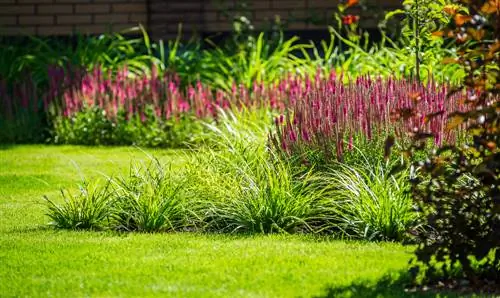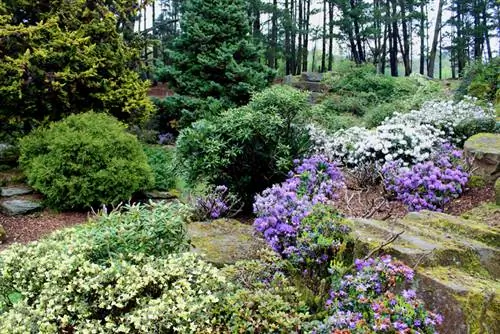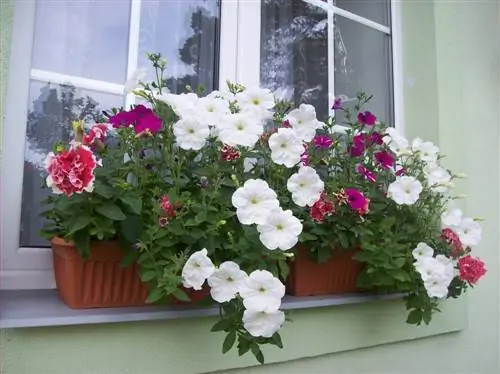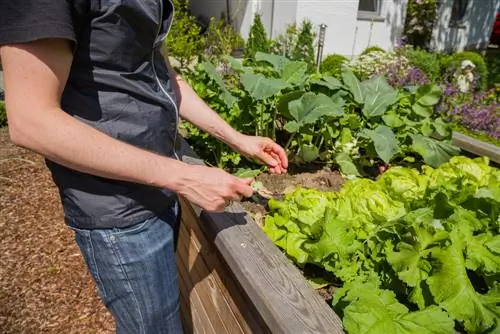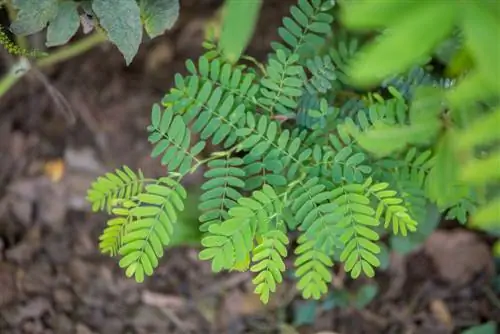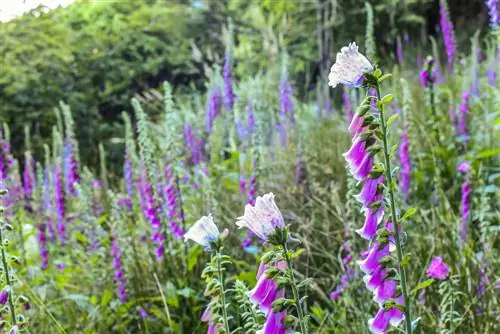- Author admin [email protected].
- Public 2024-01-15 08:07.
- Last modified 2025-06-01 06:02.
In hobby gardening, the term partial shade raises important questions. No longer wonder about its meaning and its significant influence on your plant selection. Read a compact definition with practical information here. Browse clear lists with the most beautiful partial shade plants for the garden, herbaceous bed and balcony.
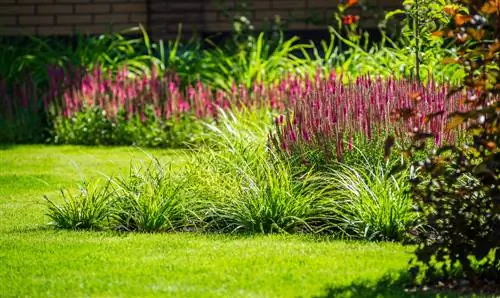
What does partial shade mean and which plants are suitable for it?
Penumbra refers to a fluctuating shade front caused by trees, hedges or walls and allows an average of 4 hours of sunshine per day. Suitable plants for partial shade include cyclamen, wood anemones, glories, rough-leaf asters and cranesbill species.
- Penal shade is created by trees, hedges and walls as a fluctuating shadow front with an average of 4 hours of sunshine per day.
- Beautiful perennials for partial shade include cyclamen, wood anemones, glories, rough-leaf asters and cranesbill species.
- Flowering shrubs such as hydrangeas, numerous rose varieties and clematis thrive in partial shade.
What does penumbra mean?
In descriptions of plant locations, partial shade is often mentioned. This term specifies the lighting conditions in the garden as an important criterion for the correct selection of plants. Partial shade is not just an intermediate between sun and shade, but is subject to permanent changes throughout the day. The following definition gets to the point:
Penal shade: a shadow front that fluctuates over the course of the day, caused by trees, hedges or walls with an average of 4 hours of sunshine daily
A bed in partial shade is sunny for up to four hours during the day and is shaded for the rest of the time. Partial shade exists, among other things, on the west and east sides of a wall or along a privacy hedge planted in a north-south direction. Depending on the orientation, plants in a partially shaded location benefit from mild morning sun or bright afternoon sun. Changes over the course of the year are the rule and are closely related to the height of the sun. If the front garden was sunny in spring, it may be shaded by the house in the afternoon in summer.
The following video explains the term partial shade, in contrast to other location descriptions such as full sun, sunny, shade and full shade.

Beautiful partial shade plants
According to the definition, plants in partial shade can enjoy the sun for a maximum of 4 hours a day. This premise limits the choice of plants for design in the garden and front yard a little. However, creative hobby gardeners do not have to do without lavish flowers in their green kingdom. The following tables provide an overview of which floral beauties are impressively presented as perennials, upholstery perennials, flowers and flowering shrubs in partial shade:
Perennials for partial shade - a selection
| Perennials | botanical name | Cushion perennials | botanical name | Continuous blooming flowers | botanical name |
|---|---|---|---|---|---|
| Aquilegia | Aquilegia vulgaris | Elf Flower | Epimedium diphyllum | Large-flowered girl's eye | Coreopsis grandiflora |
| Cyclamen | Cyclamen | Golddroplets | Chiastophyllum oppositifolium | Hussar Buttons | Sanvitalia speciosa |
| Bergenie | Bergenia | Lipped mouth evergreen | Mazus reptans | Levkoje | Matthiola incana |
| Bushwind Roses | Anemone nemorosa | Cushion Bellflower | Campanula portenschlagiana | Mallow | Lavatera trimestris |
| Funkie | Hosta | Porcelain flowers evergreen | Saxifraga x urbium | Marigold | Calendula officinalis |
| Japanese anemone | Anemone japonica | Snow carpet evergreen | Sedum spurium | Sterntalerblume | Melampodium paludosum |
| liverwort | Hepatica nobilis | Snail Knotweed | Bistorta affinis | Student flower | Tagetes |
| Magnificent Piers | Astilbe japonica | Star moss | Sagina subulata | Jewelry basket | Cosmos bipinnatus |
| Raublatt-Aster | Aster novae-angliae | Carpet Aster | Aster ericoides var. pansus | White Bertram's Sheaf | Achillea ptarmica |
| Storksbill | Geranium | White Periwinkle | Vinca miro | Zinnia | Zinnia elegans |
The climbing plants among the constantly blooming summer flowers transform trellises and house facades into a floral fairytale. Cup mallow and zinnia in our table are not the only permanent bloomers that like to create eye-catchers in partially shaded locations. Annual climbing plants such as fragrant sweet peas (Lathyrus odoratus), lavish bell vines (Cobaea), robust nasturtiums (Tropaeolum) and the legendary black-eyed Susan (Thunbergia alata) boast tireless blooms until the first frost. The floral climbing artists are also happy with partial shade, as long as the location is warm and protected from the wind.
Flowering shrubs - hardy, for partial shade and easy to care for
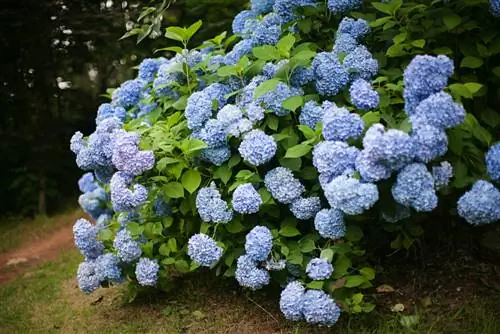
The ball hydrangea blooms profusely even in partial shade
| Flowering bushes | botanical name | Groundcover | botanical name | climbing bushes | botanical name |
|---|---|---|---|---|---|
| Ball Hydrangea | Hydrangea macrophylla | Fat Man/Shadow Green | Pachysandra terminalis | Clematis evergreen | Clematis armandii |
| Japanese Camellia | Camellia japonica | Ivy | Hedera helix | Gold Honeysuckle | Lonicera x tellmanniana |
| Laurel Rose | Kalmia latifolia | fingerbush | Potentilla tridentata | Climbing hydrangea | Hydrangea anomala |
| Sourthorn | Berberis vulgaris | Cranberry | Vaccinium macrocarpon | Climbing Rose/Rambler | Pink |
| Snow heather evergreen | Erica carnea | Red Carpet Berry | Gaultheria procumbens | pipe winch | Aristolochia macrophylla |
Representing the royal blooms of roses in partial shade, the table above mentions climbing and rambler roses. Although the queen of flowers prefers to reside in a sunny location, rambler roses that bloom once can also tolerate a location with fewer hours of sunshine. We would like to recommend the premium variety 'Bobby James' with its white flowers. Among the more frequently blooming climbing roses, the ADR rose 'Laguna' stands out with its abundance of pink flowers and fruity scent.
Excursus
Grass beauties for partial shade
With delicate lightness, ornamental grasses round off the imaginative design of the perennial bed and front garden. In a partially shaded location with countless hours of sunshine, selected beauties of grass fulfill this demanding task with flying colors. Prime examples are: Golden Japan mountain grass 'Aureola' (Hakonechloa macra), the white-edged sedge 'Snowline' (Carex conica) and the enchanting snow marbel (Luzula nivea). These ornamental grasses are also easy to care for, evergreen and hardy.
Planting tips for a picturesque partial shade bed

The combination of different sized plants allows you to create a large bed where all the plants can be clearly seen
With a well thought-out planting plan, the bed in partial shade becomes a gem in the garden. First, use a sketch plan to determine the shape so that the bed planting fits harmoniously into the overall picture of your creative garden design. The next step is to create the specific planting plan. The following tips summarize important criteria for the perfect plant composition in the picturesque partial shade bed:
- Leading perennials: tall perennials, flowering bushes and climbing plants as a backdrop and in the center form the framework
- Companion plants: half-height flowers and bushes support the leading perennials
- Filler plants: low cushion perennials and ground cover act as gap fillers
- Breakdown: 10-15% lead perennials, 30-40% companion plants, 50-60% filler plants
Raised leading perennials present themselves best as solitary plants. Companion and filler plants look great in small groups. The larger the herbaceous bed, the more often a plant variety can be represented as tuff. The border is reserved for upholstery perennials and ground cover. In the small front garden and partially shaded rock garden you can create spatial depth with the right choice of plants. Position perennials and flowers with blue flowers or dark decorative leaves in the background. In the foreground, plant small, floral space openers with pastel-colored flowers and light green, small leaves.
Tip
A richly laid table awaits bees in a partially shaded location. Proven seed mixtures ensure a bee-friendly bed design in partial shade and a rich nectar buffet. The specific premium quality bee pastures include 'Veitshöchheimer Bienenweide Halbshade', 'Bingenheimer Saatgut Bienenweide' and 'Schönhagener Bienenweide'. Balcony gardeners use the 'Mössinger Bienenweide' seed mix, perfect for partially shaded flower boxes and pots.
Balcony plants for partial shade - ideas for boxes and pots
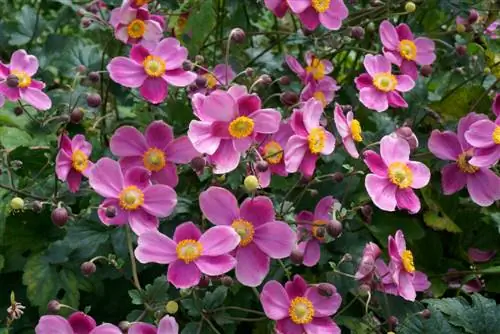
The beautiful autumn anemone can also cope with less sun
The partial shade dominates on the balcony on the east or west side of the house. What is needed here are plants that are content with a little sunshine in the morning or afternoon. You can create a lush balcony planting in partial shade, easy to care for and representative, with these floral specialists:
Flower box
- Bergenia autumn blossom (Bergenia): blooms in spring and autumn, height 25-40 cm (also beautiful in a pot)
- Mountain Forest Cranesbill (Geranium nodosum): flowering period from May to September, height 20-30 cm
- Busy Lizzie (Impatiens walleriana): flowering period from May to October, height 20-25 cm
- Ball primrose (Primula denticulata): flowering period March to June, height 10-30 cm
- Lampion flower (Physalis gigantea): flowering period from summer to autumn, height 40-60 cm
potted plants
- Autumn anemone (Anemone japonica): flowering period September to November, height 80-100 cm
- Lily hosta (Hosta Plantaginea): flowering period from August to October, height 50-80 cm
- White foxglove (Digitalis purpurea): flowering period from June to the first frost, height 120 cm
- Hardy fuchsia 'Tom Thumb' (fuchsia): flowering period from July to October, height up to 50 cm
For the fruit snack garden on the half-shaded balcony, the columnar cherry 'Sylvia' (Prunus avium), the columnar apple Ballerina 'Flamenco' (Malus) and the columnar pear 'Saphira' (Pyrus communis) are recommended as potted plants. The 'BrazelBerry' blueberry is a compact, hardy bush with fruity berry delights that also likes to be placed in large flower boxes.
Frequently asked questions
Which houseplants are suitable for a place in partial shade?
Morning or evening sun is enough for the magical pubic flower (Aeschynanthus) to develop its decorative tubular flowers. On the west or east windowsill, the elegant single leaf (Spathipyllum) doesn't take long to present its bright white bracts with the impressive spadix flowers. The tropical arrow leaf (Alocasia) has breathtaking decorative leaves. The easy-care cobbler palm (Aspidistra elatior) demonstrates its majestic presence in partial shade in living rooms and winter gardens.
What is the difference between umbra and penumbra?
If an object is illuminated by a single light source, it casts a shadow. To create an umbra, two light sources are required. In this case, the illuminated object casts two shadows that partially overlap. The shadow area from which a light source can be seen is called penumbra. The area of the shadow from which no light source can be seen is called the umbra.
Are there aromatic herbs that thrive in partial shade?
A colorful array of delicious herbal treasures thrives in the partially shaded location. These include parsley (Petroselinum crispum), chervil (Anthriscus cerefolium), dill (Anethum graveolens), lemon balm (Melissa officinalis) and oregano (Origanum vulgare). Of course, spicy sage (Salvia) and spicy chives (Allium schoenoprasum) should not be missing here. Don't forget catnip and cat grass so that your cat doesn't go away empty-handed.
Can you plant tomatoes in partial shade?
If you place tomatoes in partial shade, you will look in vain for plump, aromatic fruits. Tomato plants are native to the sun-drenched tropical regions of South America and prefer a sunny to full sun location. Tomatoes are best kept in a partially shaded location only during the cultivation and hardening phase.
Tip
If you create a vegetable patch in partial shade, you can still make the most of your choice of plants. For the planting plan, note down delicious types of cabbage, such as cauliflower, Brussels sprouts or kale. Bush beans, peas, cucumbers, kohlrabi, carrots, leeks, radishes, beetroot, all kinds of salads as well as spinach and onions provide you with rich harvest yields.

